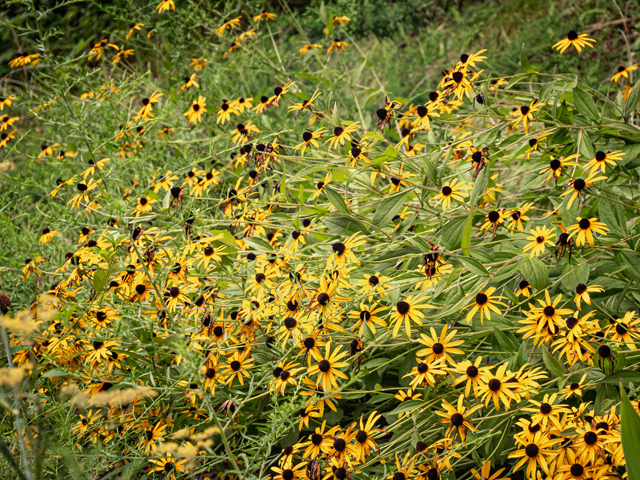Photograph by: wildflower.org
What is this plant?
Black-Eyed Susans (Rudbeckia hirta) is a North American lant in the sunflower family. The plant is native to Eastern and Central North America. Black-Eyed Susans (Rudbeckia hirta) are also naturalized in the Western part of the continent and in China. It has now been found in all 10 Canadian provinces. The plant can grow up to 3 feet tall and has leaves that are about 6 inches long. They are great butterfly, bird, bee, and other wildlife attractors. Black-Eyed Susans are vigorous and love the sun! The species is hermaphrodite (has both male and female organs) and is pollinated by bees.
Plant Information
Plant Type: Perennial
Light: Full sun
Height: 1-3 feet
Days to Maturity: Seeds can germinate in 3-4 weeks. If seeds sown early, flowers can bloom first year
Zone: 3-9
Color: Yellow, Orange, Red
Bloom Time: March – November
Other: Plant is drought tolerant once established, great for attracting pollinators
Growing from Seed
- Sow seeds about 6 weeks before the last frost, if planting from seed
- For optimal growing, soil temperature should be about 70-75°F
- If growing seeds indoors, sprinkle the seeds on top of the seed starting mix and do not cover (seeds need optimal light)
- Once seedlings have sprouted from indoor seeds, plant them in the ground when there is no threat of frost
Growing from Seedling
- Plant seedlings or plants about 18 inches apart
- Remove any weeds and loosen the soil
- Dig a hole that is a few inches wider than the plant
- Set the plant in the hole and cover with soil, tamping gently
- Add water!
Growing & Care Tips
It is recommended to check the plants frequently for watering. Avoid overwatering, but also ensure the plant has enough moisture (especially during the early seasons of it’s life). If you cut back the plant after the first bloom, there can be a second, smaller bloom in the fall. After the first year, Black-Eyed Susans will self-seed and may overtake nearby flowers in the seasons to come. Remove any dead plant material in the springtime to promote new growth and to keep the plant healthy.
Plant Uses & Benefits
- Great pollinator
- Attracts butterlies, bees, and other wildlife
- Flowers for bouquets
- The roots have been used for medicinal purposes
- Deer-resistant
History of the Plant
Black-Eyed Susans have been used to represent justice. The species name (hirta) is Latin for ‘”hairy” and is used for this plant because of the short bistles on the leaves. Some Native Americans used Black-Eyed Susans for medicinal purposes to treat colds, dropsy, and worms in children. A mixture using Black-Eyed Susans has been used to treat snake bites. The liquid from Black-Eyed Susan roots has been used to treat earaches.
References
www.almanac.com
www.wildflower.org

